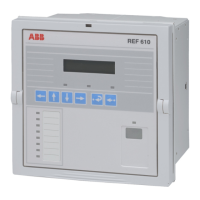157
6. Application examples
6.1. Auto-reclose function
6.1.1. Fast tripping and initiation of shot 1 using two protection
elements
In several applications, such as fuse-saving applications involving down-stream
fuses, tripping and initiation of shot 1 should be fast (instantaneous or short-time
delayed) and of shot 2 and 3, and definite tripping time delayed. In this example,
two overcurrent elements are used, 51P and 50P-1. Element 50P-1 is given an
instantaneous characteristic and Element 51P a time delay. By setting SG2/2 to 1
and SG2/7 to 1, Element 50P-1 will be blocked by the AR function during shot 2
and 3.
50P-1
51P
SG2/2=1
SG2/7=1
79
Trip
Trip
Block 50P-1
Close CB
CB closed
CB open
Shot 1
Shot 2 Shot 3
Definite Trip
50P-1 Trip
Block 50P-1 at
Shot 1, 2 and 3
Block 50P-1
Open CB
Open CB
51P Trip 51P Trip
51P Trip
50P-1
TDLY
51P TDLY
51P TDLY
51P TDLY
Block 50P-1 Block 50P-1
A070040
Fig. 6.1.1.-1 Fast initiation of shot 1 using one fast and one delayed element
In case of a short-circuit in the network, element 50P-1 will trip the circuit breaker
and initiate shot 1. At the time of shot initiation, the blocking of element 50P-1 will
be activated. If the network fault is not cleared, element 51P will trip the circuit
breaker and continue the auto-reclose sequence to shot 2, shot 3 and finally definite
tripping.
As the set pickup value of element 51P in this example is higher than that of element
50P-1, as sometimes is the case, it is possible that the current will not exceed the set
pickup value of element 51P while the blocking of element 50P-1 is active. This will
lead to a pumping effect when the AR function is reset (the blocking of element
50P-1 included), i.e. the AR sequence will pickup over and over again.
Feeder Protection Relay
Technical Reference Manual - ANSI Version
REF610REF610
1MRS755535

